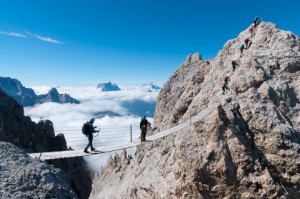
Climbing is the activity of using your hands and/or feet to ascend a steep object. It is pursued both recreationally, either to get to a destination otherwise inaccessible, or for its own enjoyment, and also professionally, as part of activities such as maintenance of a structure, or military operations.
Climbing activities include the following:
- Mountain climbing (Mountaineering) : Ascending mountains for sport or recreation.
- Rock climbing :Ascending rock formations, often with climbing shoes and a chalk bag. Equipment such as ropes, bolts, nuts, hexes and camming devices are normally employed, either as a safeguard or for artificial aid.
- Ice climbing :Ascending ice or hard snow formations using special equipment designed for the purpose, usually ice axes and crampons. Protective equipment is similar to rock climbing, although protective devices are different (ice screws, snow wedges).
- Bouldering :Ascending boulders or small outcrops, often with climbing shoes and a chalk bag or bucket. Usually, a safety rope from above is not employed – instead, a crash pad (a combination of high and low density foam, within a heavy duty fabric structure, often transported on the back) and a human spotter (to direct a falling climber on to the pad) are used to avoid injury.
- Buildering :Climbing urban structures – usually without equipment – avoiding normal means of ascent like stairs and elevators. Aspects of buildering can be seen in the art of movement known as Parkour
- Tree climbing : Ascending trees without harming them, using ropes and other equipment. (A less competitive activity than rock climbing)
- Rope climbing : Climbing a short, thick rope for speed. Not to be confused with roped climbing, as in rock or ice climbing.
- Pole climbing (gymnastic) : Climbing poles and masts without equipment.
- Pole climbing (lumberjack) : Lumberjack tree-trimming and competitive tree-trunk or pole climbing for speed using spikes and belts.
Rock, ice, and tree climbing have a common feature: all three normally employ ropes for either safety or aid. Pole climbing and rope climbing were among the first exercises to be included in the origins of modern gymnastics in the late 18th century and early 19th century. The sport of Mountaineering usually requires rock and/or ice climbing.
Climbing in popular culture
 Climbing has been featured in many popular movies, such as Cliffhanger or Mission: Impossible II, but save for a few exceptions (The Eiger Sanction and Touching the Voidbeing examples) it is generally given an inaccurate portrayal by Hollywood and much of the popular media. The sport of rock climbing was swept up in the extreme sport craze in the late 1990s which led to images of rock climbers on everything from anti-perspirant and United States Marine Corps commercials, to college promotional materials. Both pole and rope climbing can be seen in circus performances, such as Cirque du Soleil. The Czech republic and France have resurrected the sport of rope climbing – once an official gymnastic event in the Olympic Games, but dropped after 1932- and contests are held in public gathering places, such as shopping centers, as well as in gymnasiums. Pole and mast climbing were popular in the 18th and 19th century in village festivals in certain parts of Europe, and were still part of the physical education curriculum at the United States Naval Academy in the 1960s.
Climbing has been featured in many popular movies, such as Cliffhanger or Mission: Impossible II, but save for a few exceptions (The Eiger Sanction and Touching the Voidbeing examples) it is generally given an inaccurate portrayal by Hollywood and much of the popular media. The sport of rock climbing was swept up in the extreme sport craze in the late 1990s which led to images of rock climbers on everything from anti-perspirant and United States Marine Corps commercials, to college promotional materials. Both pole and rope climbing can be seen in circus performances, such as Cirque du Soleil. The Czech republic and France have resurrected the sport of rope climbing – once an official gymnastic event in the Olympic Games, but dropped after 1932- and contests are held in public gathering places, such as shopping centers, as well as in gymnasiums. Pole and mast climbing were popular in the 18th and 19th century in village festivals in certain parts of Europe, and were still part of the physical education curriculum at the United States Naval Academy in the 1960s.
Content courtesy of Wikipedia
Find Out More about Climbing
If you want to find out more about climbing, visit the British Mountaineering Club website.
